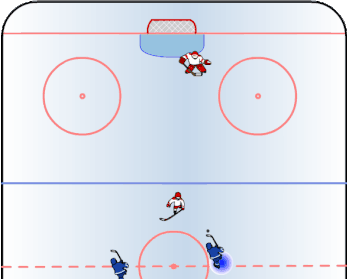| This article needs additional citations for verification. Please help improve this article by adding citations to reliable sources. Unsourced material may be challenged and removed. Find sources: "One timer" – news · newspapers · books · scholar · JSTOR (July 2022) (Learn how and when to remove this message) |

In ice hockey, a one-timer is a shot that occurs when a player meets a teammate's pass with an immediate slapshot, without any attempt to control the puck on their stick. An effective one-timer requires precise timing on the part of both players involved, especially the shooter. This play improves the shooter's chances at scoring a goal. A wrist shot can also be done on a one-timer, though the puck is released far slower than a slapshot one-timer.
The effectiveness of the one-timer comes from three things:
- The angle from goal between the pass and the shot
- The change of direction of the puck
- The speed of the puck after the shot
Greater angle, change of direction and/or speed increases the chances of the puck going into the net. Lesser angle, change of direction and/or speed decreases the chance of the puck going into the net.
Either way, the one-timer enjoys a greater success rate than a one-on-one shot between shooter and goalie.
The reason it is called a one-timer is that the player has only one time to connect.
References
- "What is a One-Timer? Hockey Shots Explained - BS Hockey". Retrieved 2022-07-27.
- Stimson, Ryan (2017-01-17). "Analyzing One-Timers: The Most Dangerous Shot in the Bag". Hockey Graphs. Retrieved 2022-07-27.
| Ice hockey | |||||
|---|---|---|---|---|---|
| Equipment | |||||
| Positions |
| ||||
| Rules | |||||
| Skills | |||||
| Variations | |||||
| Strategy | |||||
| Terminology |
| ||||
| Statistics | |||||
| Related topics | |||||
This ice hockey article is a stub. You can help Misplaced Pages by expanding it. |